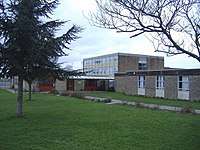Katharine Lady Berkeley's School
Katharine Lady Berkeley's School is an academy school near Wotton-under-Edge, Gloucestershire, England, for ages 11 to 18. It was founded by Lady Berkeley for the use of six scholars in 1384 which makes it one of the oldest surviving schools in England.[1]
| Katharine Lady Berkeley's School | |
|---|---|
 | |
| Address | |
Wotton Road , , GL12 8RB England | |
| Coordinates | 51°37′54″N 2°21′51″W |
| Information | |
| Type | Academy |
| Motto | non palma sine pulvere (no reward without effort) |
| Religious affiliation(s) | Mixed |
| Established | 1384 |
| Founder | Lady Katharine Berkeley |
| Department for Education URN | 137033 Tables |
| Ofsted | Reports |
| Headteacher | Tim Rand (2019 -) |
| Gender | Coeducational |
| Age | 11 to 18 |
| Enrolment | 1,470 |
| Houses | Wellicome (Red), Berkeley (Green), Durand (Blue), Logan (Yellow) |
| Website | http://www.klbschool.org.uk |
The old school buildings in School Lane, Wotton-under-Edge, were erected in 1726 with additions later. Shortly after the school had become co-educational, Church Mill was bought in 1908. After the First World War, Carlton House was rented from the Post Office.
In January 1963, the school vacated the premises in Wotton and moved into a new building for 350 pupils in the Kingswood Road. The erection of the first phase of extensions to the Kingswood Road buildings began in March 1972. The extensions were completed for the start of the Autumn Term 1973, when Katharine Lady Berkeley's re-opened as a comprehensive school for 830 pupils. Wotton Secondary School closed at the end of August 1973. The second phase of extensions was completed in September 1975.
In 1984 the six hundredth anniversary of the foundation of the school was celebrated with a visit from Princess Anne.
In 1989, the Duke of Gloucester opened the Renishaw Centre, an IT room costing £60,000 and since then the School has installed three more computer rooms. The Renishaw Company renewed the equipment in the Renishaw Centre, with the former hardware being transferred to the Special Needs Department.
In 1992, grant-maintained (GM) status was attained, with the object of providing for the structural improvement of the buildings and a wish to be able to make independent decisions to suit the school's future. In 1996, the school achieved designation as a Language College which attracted additional funding from central government. This enabled the school to offer a languages curriculum covering seven modern languages and Latin.
In 1994, accommodation was added to allow for the increase in numbers, from 1,010 in 1984 to 1,170 in 1994 and then to 1,340 in 1998. Further new buildings were completed in September 1997 to provide six more classrooms and the Language Centre costing £220,000 was opened in September 1996. In autumn 1999, work began on further new buildings to provide a new two storey teaching block which includes 11 classrooms, three ICT suites and a new library. In addition to this a three laboratory extension was added to the Science Centre.
In 2003, a major new extension was added to the Music block and a small network of computers installed. One of the rooms in the Humanities block was converted into a cross-curricular computer suite. The Business Studies ICT suite was upgraded into a full computer suite.
In 2004, a new single-story block was added between the existing Science and Music blocks. This accommodates a new ICT suite, three new classrooms and two small meeting/seminar rooms.
In 2005, the reception area was refurbished with new office accommodation added. Since then the Music block has been extended and two further classrooms have been converted to ICT suites.
In 2007, the school gained a second DfES specialism, that of training school. The school population has stabilized at around 1500 pupils. On 16 January 2008, the school had an Ofsted inspection and received 'Good' overall, with an 'Outstanding' for the Sixth Form.
In September 2011, the school became an academy, directly funded by central government and independent of control by local government.
In June, July and August 2017, the school went through physical changes. The Science block had 8 of its 11 rooms completely remade. Two signs of the school's logo were placed by the Sports Hall and Reception. Some other rooms were also redecorated.
Notable former pupils
- William Tyndale, scholar[2]
- Edward Jenner, physician and scientist[2]
- Matthew Blagden Hale, Anglican bishop[3]
- Catherine Johnson, playwright[4]
- Simon Mason, England hockey goalkeeper[5]
- Sean Rigg, professional footballer[6]
- Ben Morgan, England rugby union player[7]
References
- Student populations in 1384 can be found by navigating to the location of the school on http://www.domesday1986.com/ Archived 2008-12-02 at the Wayback Machine
- "Archived copy". Archived from the original on 15 May 2010. Retrieved 26 March 2013.CS1 maint: archived copy as title (link)
- "Contact Us". Archived from the original on 26 October 2016. Retrieved 26 July 2017.
- "Bristol's Mamma Mia! writer recalls her opening night". This Is Bristol. 11 April 2009. Archived from the original on 5 May 2013. Retrieved 26 March 2013.
- "Alan Hooper receives lifetime achievement award from the Gloucestershire Hockey Association". Gazette. 23 June 2012. Retrieved 26 March 2013.
- "Former Wotton-under-Edge schoolboy Sean Rigg shines in FA Cup against Liverpool". 6 January 2015. Retrieved 3 April 2017.
- "RFU". Archived from the original on 11 July 2014. Retrieved 4 August 2014.